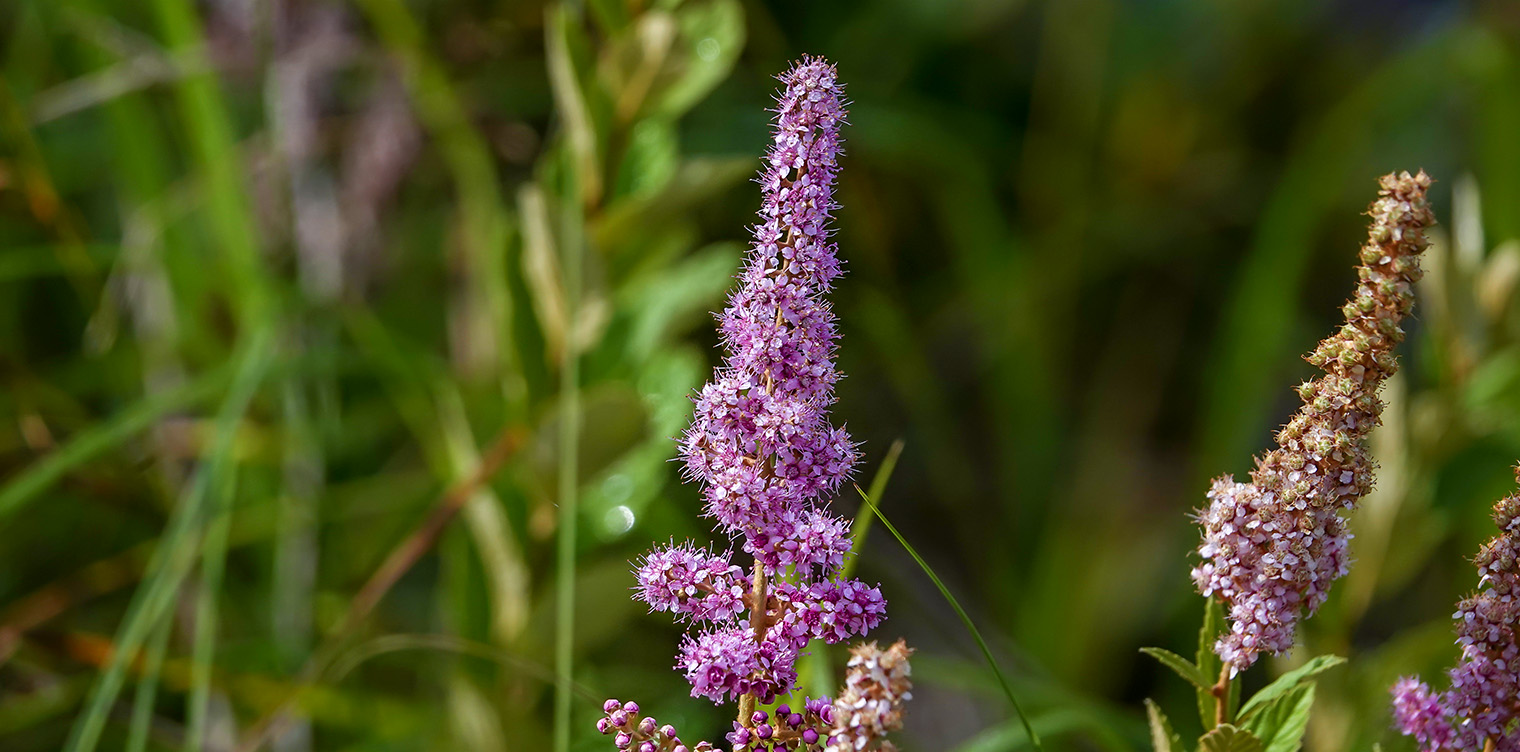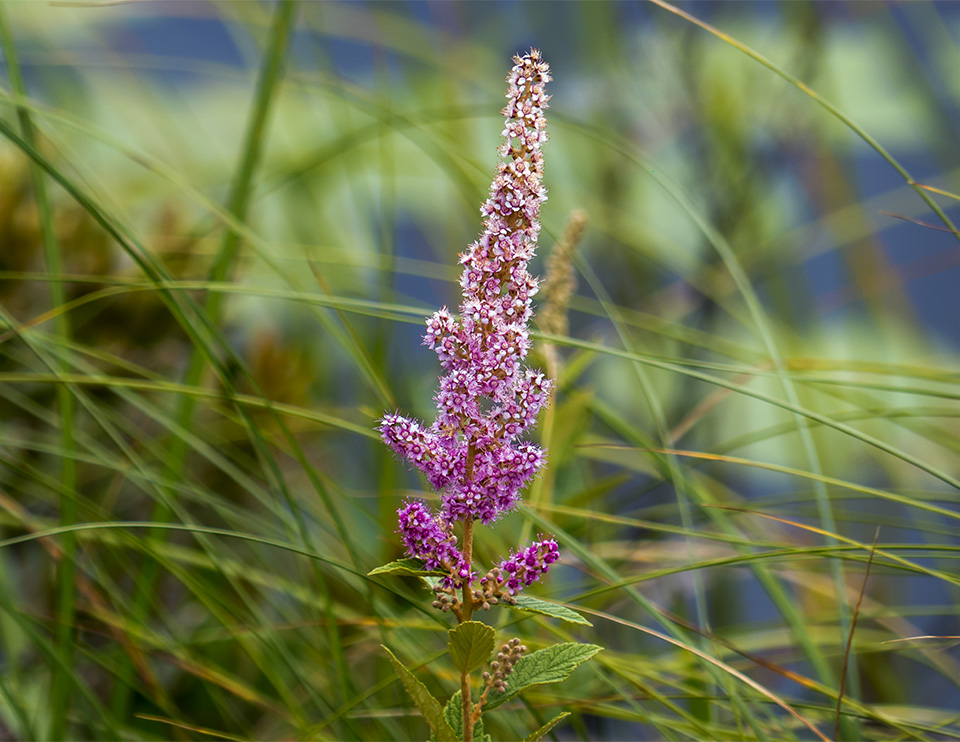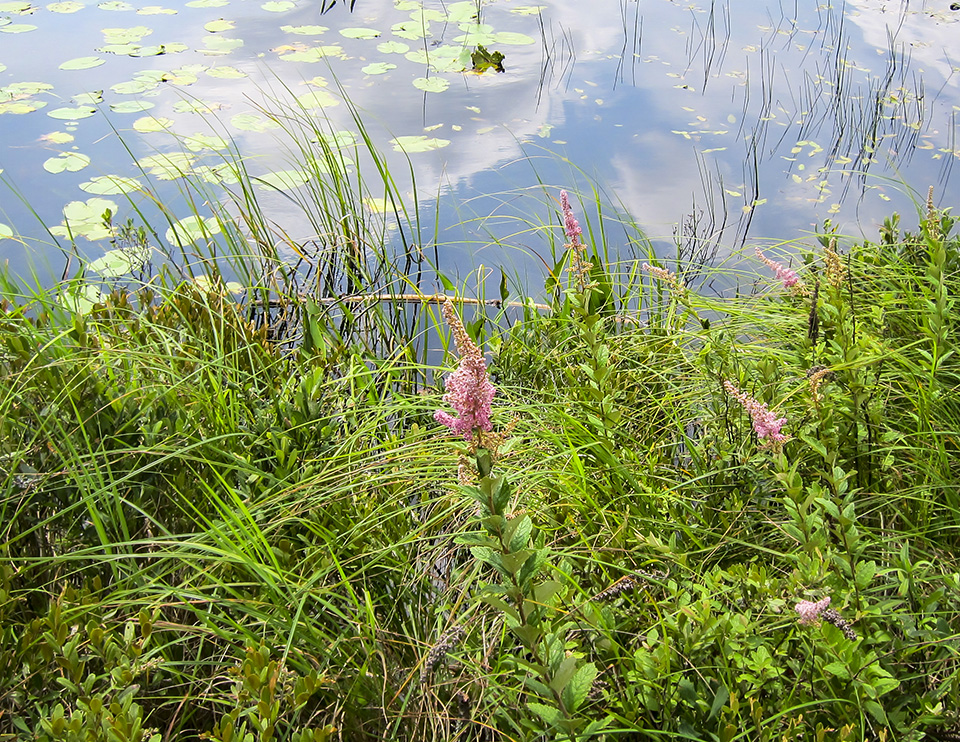Shrubs of the Adirondacks:
Steeplebush (Spiraea tomentosa)

Steeplebush (Spiraea tomentosa) is a native deciduous shrub which produces spike-like clusters of deep pink flowers in summer. It grows in Adirondack wetlands and moist fields. Steeplebush is a member of the Rose Family (Rosaceae).
- The genus name (Spiraea) comes from an ancient Greek word, meaning "a spiraled or twisted wreath." It refers to the twisted seed pod of some of these species. The species name (tomentosa) means "covered with densely matted hairs."
- The common name (Steeplebush) is a reference to the steeple-like clusters of rose-pink flowers which appear in summer. Other common names for this plant include Hardhack and Hardhack Spiraea. The term "hardhack" is a reference to the problems early farmers encountered cutting the plant in their meadows. Even after the plants were cut, they could send out new stems from their roots.
A similar species, Meadowsweet, does not have woolly twigs or hair on the undersides of the leaves. Another similar species, Japanese Spiraea (S. japonica), is a nonnative invasive plant; it has flat-topped clusters of pink flowers.
Identification of Steeplebush

This plant forms a mound-shaped thicket of slender, unbranched stems, two to four feet tall. The twigs are covered with densely-matted, woolly hairs.
The leaves are alternate, meaning that they emerge from the stem one at a time. They are generally elliptical in shape, about 2.5 inches long and one inch wide. The edges have teeth. The upper leaf surface is dark green; the lower surface is covered with dense woolly hairs.
The pink to rose-purple flowers have five petals and numerous long pink stamens. They are about 1/16 inch wide and form a densely-packed cluster three to four inches wide and up to eight inches long. The flowers are hermaphrodite (have both male and female organs).
Steeplebush usually blooms in the Adirondack region in late summer, depending on the weather. A tally of flowering dates for the upland Adirondack areas compiled by Michael Kudish, based on data collected from the early seventies to the early nineties, lists the flowering times from 2 August to 21 August. The pattern of Adirondack Park iNaturalist observations suggests a somewhat expanded bloom time in more recent years, from late July to late August.
The fruit of the Steeplebush follows the flowers. The fruit is a cluster of five tiny pods, each with a single seed. The fruit is covered with a dense, woolly white mat.
Uses of Steeplebush
Steeplebush has no known edible uses. The plant was used in the past by a few native American groups for medicinal purposes. The Algonquin reportedly used an infusion of leaves and stems as a medicinal tea. The Mohegans are said to have used an infusion of leaves to treat dysentery. The Ojibwa used an infusion of leaves and flowers for sickness in pregnancy and for easing childbirth.
Wildlife Value of Steeplebush

This species is not a food source for mammals. Butterflies and other nectar-feeding insects are said to find the flowers highly attractive.
Distribution of Steeplebush
Steeplebush can be found in the eastern half of the US and Canada. It appears from Ontario and Quebec south to Georgia and Mississippi.
Steeplebush is found in most counties in the eastern part of New York State. Its presence has been documented by vouchered plant specimens in all counties within the Adirondack Park Blue Line.
Habitat of Steeplebush
Steeplebush prefers wet, moderately acid soils. It is shade-intolerant and prefers full sun. As a result, look for this species in sunny or slightly shady areas in swamps, open moist ground, and along streams and ponds. Although Steeplebush is most commonly found in poorly drained areas, it is also occasionally found on well-drained soils. Steeplebush is sometimes found growing with its cousin, Meadowsweet.
In the Adirondack Park, Steeplebush is found in several ecological communities, including:
Steeplebush may be seen along many trails that pass through or skirt moist areas, such as the Heron Marsh Trail and the Black Pond Trail at the Paul Smith's College VIC. You can also find Steeplebush growing on Bloomingdale Bog; look for it where the old railway right-of-way crosses Rickerson Brook.
References
Michael Kudish. Adirondack Upland Flora: An Ecological Perspective (Saranac, New York: The Chauncy Press, 1992), p. 159.
New York Flora Association. New York Flora Atlas. Steeplebush. Spiraea tomentosa L. Retrieved 3 February 2019.
United States Department of Agriculture. The Plants Database. Steeplebush. Spiraea tomentosa L. Retrieved 11 April 2017.
Flora of North America. Spiraea tomentosa Linnaeus. Retrieved 11 April 2017.
NatureServe Explorer. Online Encyclopedia of Life. Spiraea tomentosa - L. Retrieved 11 April 2017.
Northern Forest Atlas. Images. Spiraea tomentosa. Steeplebush. Retrieved 11 April 2017.
New York State. Department of Environmental Conservation. New York Natural Heritage Program. Ecological Communities of New York State. Second Edition (March 2014), pp. 49, 55-56, 60, 64. Retrieved 17 October 2015.
New York Natural Heritage Program. 2021. Online Conservation Guide for Dwarf Shrub Bog. Retrieved 4 August 2021.
New York Natural Heritage Program. 2021. Online Conservation Guide for Medium Fen. Retrieved 4 August 2021.
New York Natural Heritage Program. 2021. Online Conservation Guide for Sedge Meadow. Retrieved 4 August 2021.
New York Natural Heritage Program. 2021. Online Conservation Guide for Shallow Emergent Marsh. Retrieved 4 August 2021.
New York Natural Heritage Program. 2021. Online Conservation Guide for Shrub Swamp. Retrieved 4 August 2021.
iNaturalist. Steeplebush. Spiraea tomentosa. Retrieved 4 August 2021.
iNaturalist. Adirondack Park Observations. Steeplebush. Spiraea tomentosa. Retrieved 4 August 2021.
New York State. Adirondack Park Agency. Preliminary List of Species Native Within the Adirondack Park Listed Alphabetically by Scientific Name and Sorted by Habit. Volume 1. Updated 10.23.2006, p. 10. Retrieved 26 January 2017.
Connecticut Botanical Society. Steeplebush. Retrieved 11 April 2017.
University of Wisconsin. Flora of Wisconsin. Spiraea tomentosa. Retrieved 11 April 2017.
University of Wisconsin. Shrubs of Wisconsin. Spiraea tomentosa. Hard Hack. Retrieved 11 April 2017.
Minnesota Wildflowers. Spiraea tomentosa. Steeplebush. Retrieved 11 April 2017.
Lady Bird Johnson Wildflower Center. Spiraea tomentosa. Retrieved 11 April 2017.
Plants for a Future. Spiraea tomentosa - L. Retrieved 11 April 2017.
University of Michigan. Native American Ethnobotany. A Database of Foods, Drugs, Dyes and Fibers of Native American Peoples, Derived from Plants. Spiraea tomentosa L. Steeplebush. Retrieved 11 April 2017.
Steven Foster and James A. Duke. Medicinal Plants and Herbs of Eastern and Central North America (Houghton Mifflin Harcourt, 2014), p. 326.
Doug Ladd. North Woods Wildflowers (Falcon Publishing, 2001), p. 99.
Lawrence Newcomb. Newcomb's Wildflower Guide (Little Brown and Company, 1977), pp. 310-311.
Roger Tory Peterson and Margaret McKenny. A Field Guide to Wildflowers. Northeastern and North-central North America (Houghton Mifflin Company, 1968) pp. 224-225, 284-285.
National Audubon Society. Field Guide to Wildflowers. Eastern Region. (Alfred A. Knopf, 2001), p. 761.
William K. Chapman, et al. Wildflowers of New York in Color (Syracuse University Press, 1998), pp. 54-55.
William K. Chapman and Alan E. Bessette. Trees and Shrubs of the Adirondacks: A Field Guide (North Country Books, 1990), p. 49, Plate 17.
Anne McGrath. Wildflowers of the Adirondacks (EarthWords, 1981, 2000), p. 68, Plate 17.
Steven Clemants and Carol Gracie. Wildflowers in the Field and Forest: A Field Guide to the Northeastern United States (Oxford University Press, 2006), pp. 70-71.
Meiyin Wu and Dennis Kalma. Wetland Plants of the Adirondacks. Ferns, Woody Plants, and Gramminoids(Trafford Publishing, 2010), p. 107.
John Krichner and Gordon Morrison. A Field Guide to Eastern Forests (Houghton Mifflin Company, 1998), pp. 191, 326, 392-393.
Donald W. Stokes. The Natural History of Wild Shrubs and Vines. Eastern and Central North America (Harper & Row, Publishers, 1981), pp. 78-83.
Allen J. Combes. Dictionary of Plant Names (Timber Press, 1994), pp. 174-175.
Charles H. Peck. Plants of North Elba (Bulletin of the New York State Museum, Volume 6, Number 28, June 1899), p. 88. Retrieved 22 February 2017.
